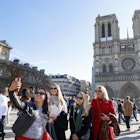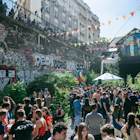
Been there, Notre-Dame that: Paris off the beaten track

Nov 12, 2018 • 6 min read

The best views of the French capital don't always come from heading up the Eiffel Tower © Neirfy / Shutterstock
Paris' prevailing popularity saw the greater area welcome more than 40 million overnight visitors in 2017, but despite these record-breaking figures, it's easy to escape the crowds.
The French capital offers plenty of under-the-radar alternatives to its most famous monuments, museums, palaces and expansive green spaces – you just need to know where to look.

Parisian views
Swap a trip up the Eiffel Tower for a less pressured vantage point (as a bonus, you'll also get views of the city's signature spire). Central Paris' low-rise skyline means that even though ground-breaking cultural space the Centre Pompidou is only six storeys high, its rooftop offers uninterrupted views (inexpensive roof-only tickets are available).
Conversely, skyscraper Tour Montparnasse (whose controversial 1970s construction prompted a crackdown on high rises) stretches to 59 storeys – though note its observation deck will close from late 2019 to 2023 while the building receives an eco-friendly overhaul with translucent windows and hanging gardens to integrate it into the cityscape.
The Arc de Triomphe's viewing platform is counterpointed by the modern Grande Arche de la Défense, just west in the city's business district of La Défense (reached by a regular metro ticket). Hilltop basilica ³§²¹³¦°ùé-°ä²Õ³Ü°ù has sweeping views from its forecourt and, more uniquely, its dome, but some of the best - and free! - city views radiate from the roofs of department stores Galeries Lafayette and Le Printemps.

Museums
Paris has over 200 museums, providing peaceful alternatives to the big hitters. The works of French Romantic artist Eugène Delacroix can be found in the Louvre, for instance, but also at the delightful Musée National Eugène Delacroix (you can also see his frescoes at the colonnaded church Église St-Sulpice).
Fans of impressionism and post impressionism can bypass the queues at the Musée d'Orsay and (to a lesser extent) the Musée de l'Orangerie, home to Monet's monumental Water Lilies, by heading to the Musée Marmottan Monet, in the duc de Valmy’s former hunting lodge. At the Petit Palais' Musée des Beaux-Arts de la Ville de Paris (City of Paris Museum of Fine Arts), alongside medieval and Renaissance objets d’art, you'll find paintings by artists including Cézanne, Monet and Gauguin.
Modern and contemporary art is showcased at the comprehensive Centre Pompidou's Musée National d'Art Moderne but also at smaller venues like the city-run Musée d’Art Moderne de la Ville de Paris. Or take a concentrated look at a single artist at venues such as the Espace DalÃ, which has more than 300 works by surrealist Salvador DalÃ, and the 2018-opened , with 350 sculptures, 90 paintings and over 2000 drawings by Alberto Giacometti, who lived and worked in Paris around the same time as Dalà and Picasso.

You can often catch a quiet moment in the exquisite sculpture gardens of the Musée Rodin (where Rodin's works include The Thinker), while the Musée Bourdelle displays magnificent bronzes by one of his pupils, Antoine Bourdelle (1861–1929). The Musée Maillol has sculptures by Aristide Maillol as well as works by Matisse, Gauguin, Kandinsky, Cézanne and Picasso. Along the Seine, wander through an open-air sculpture gallery, the Musée de la Sculpture en Plein Air.
L'Atelier des Lumières is dedicated to digital art. 'Anti-museums' Art 42 and L'Aerosol showcase Paris' trailblazing street-art scene, while specialist museums cover everything from wine (try the Musée du Vin) to perfume (such as Nouveau Musée du Parfum), cinema (the Cinémathèque ¹ó°ù²¹²Ôç²¹¾±²õe), magic (the Musée de la Magie), hunting (the Musée de la Chasse et de la Nature) and ultra-niche subjects like the and .
Palaces
A 40-minute train journey southwest of the city, the opulent Château de Versailles is a hugely popular day trip. Several other resplendent châteaux are also just a short hop from the city, and attract fewer crowds. They include the 1900-room Château de Fontainebleau, a 40-minute train ride southeast of central Paris in the forest-enveloped town of Fontainebleau; the Château de Vaux-le-Vicomte, a 35-minute rail journey to Verneuil-l'Étang followed by a shuttle bus or taxi, which regularly hosts candlelight visits and fountain displays; and the Château de Chantilly (where the eponymous whipped cream was invented), set on a shimmering lake just a 25- to 45-minute train ride northeast of Paris' centre. Like Versailles, all have magnificent formal gardens.

Parks
Adjacent to the Louvre, the elegant Jardin des Tuileries sees plenty of visitors. Parisian favourite the Jardin du Luxembourg has more space to spread out, but also gets busy on sunny days. A central alternative is sprawling Parc Monceau, with winding paths and ponds. Out-of-the way gems include the hilly Parc des Buttes Chaumont in the city's northeast, and rambling Parc Montsouris in the south; sections of the Petite Ceinture railway line - the steam train that once encircled Paris - cut through both parks.
Wine-producing grapevines flourish in parks such as the Parc de Belleville, with elevated city views, and the Parc de Bercy, adjacent to the former wine warehouses on Cour St-Émilion that now house shops and restaurants making up Bercy Village. Beyond Bercy on the city's eastern edge, the 995-hectare forest Bois de Vincennes is vast enough to find solitude, as is the 846-hectare Bois de Boulogne in the west.

Churches
Queues for the city's landmark cathedral Notre Dame can be huge, as can the lines to climb its towers, yet scores of beautiful churches across the city typically require no wait at all.
Next to former wholesale markets-turned-shopping and transport hub Les Halles, the Gothic Église St-Eustache is a trinity of history (this is where Richelieu and Molière were baptised, Louis XIV celebrated his first Holy Communion and Mozart held his mother's funeral Mass), art (with works by Rubens and Keith Haring, among others) and music (its organ is one of France's largest; there are free recitals on Sundays). Close by, the soaring Église St-Germain l’Auxerrois, blending Gothic and Renaissance styles, has similar ground plans to Notre Dame.
Within the Latin Quarter's Église St-Étienne du Mont, a chapel contains the tomb of Ste Geneviève, Paris' patron saint. Just north of central Paris in St-Denis, reached by metro, enormous Gothic basilica the Basilique de St-Denis, France's royal necropolis, has Europe's largest collection of funerary art in its crypt.

Tours
Local-led tours are one of the best ways visitors can veer off Paris' beaten track. Parisien d’un Jour – Paris Greeters volunteers take you to their favourite spots in the city. Ça Se Visite tours delve into the little-touristed northeastern neighbourhoods.
Street Art Paris leads tours of the city's hotbeds of creativity. To get to the heart of French gastronomy, take an early-morning tour of Paris' immense wholesale markets, the Marché International de Rungis.
Alternatives to busy river cruises include the hop on, hop off Batobus ferry service along the Seine, or a tranquil boat trip with companies such as Canauxrama between central Paris and the futuristic Parc de la Villette via the picturesque Canal St-Martin. The canal's towpaths and its surrounding design shops and vintage boutiques are also well worth exploring on foot, ending at a waterside cafe.
Explore related stories



 Festivals & Events8 of the best cities in Europe to celebrate New Year’s Eve
Festivals & Events8 of the best cities in Europe to celebrate New Year’s EveNov 6, 2024 • 7 min read
 Solo Travel20 expert solo travel tips for women from the Ïã¸ÛÁùºÏ²Ê¼´Ê±¿ª½± team
Solo Travel20 expert solo travel tips for women from the Ïã¸ÛÁùºÏ²Ê¼´Ê±¿ª½± teamOct 31, 2024 • 11 min read
 ArchitectureNotre Dame reveals December opening date amid debate over entry fee
ArchitectureNotre Dame reveals December opening date amid debate over entry feeOct 31, 2024 • 5 min read
 Art and CultureFrance itineraries: 5 routes to see the best of the country
Art and CultureFrance itineraries: 5 routes to see the best of the countryOct 24, 2024 • 13 min read

 Art and Culture3 days in Paris: the ultimate itinerary (when you've done the Louvre and the Eiffel Tower)
Art and Culture3 days in Paris: the ultimate itinerary (when you've done the Louvre and the Eiffel Tower)Aug 23, 2024 • 8 min read

